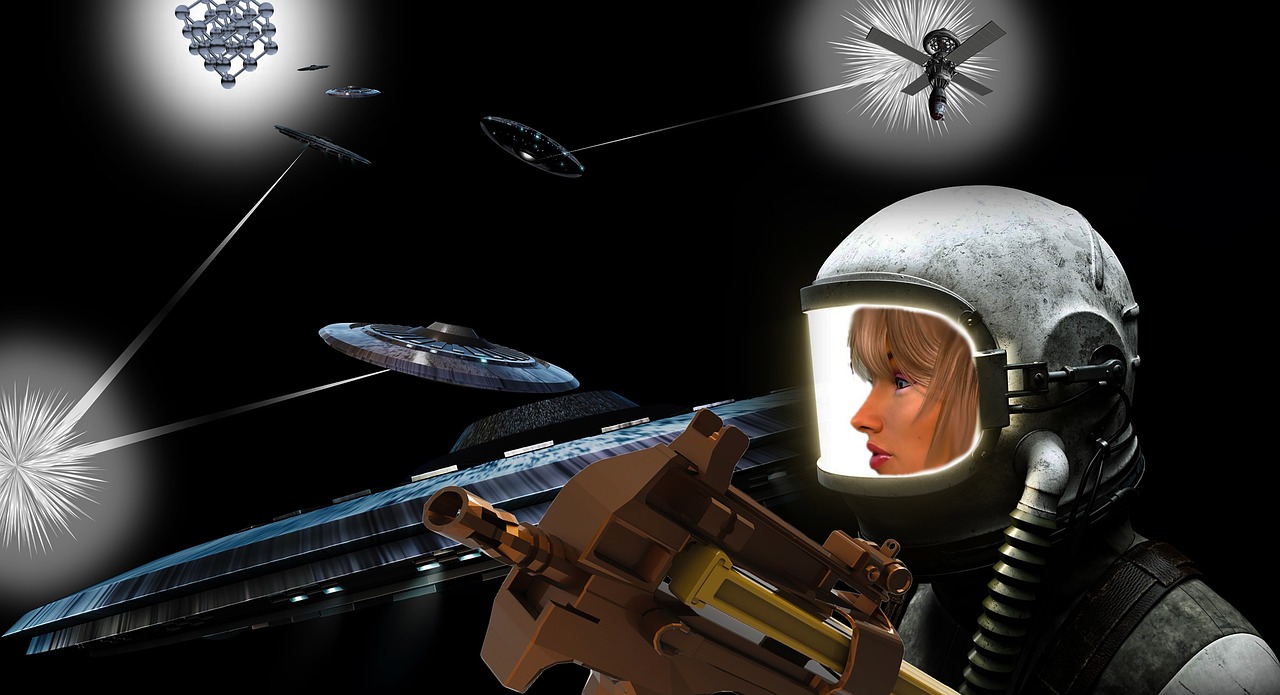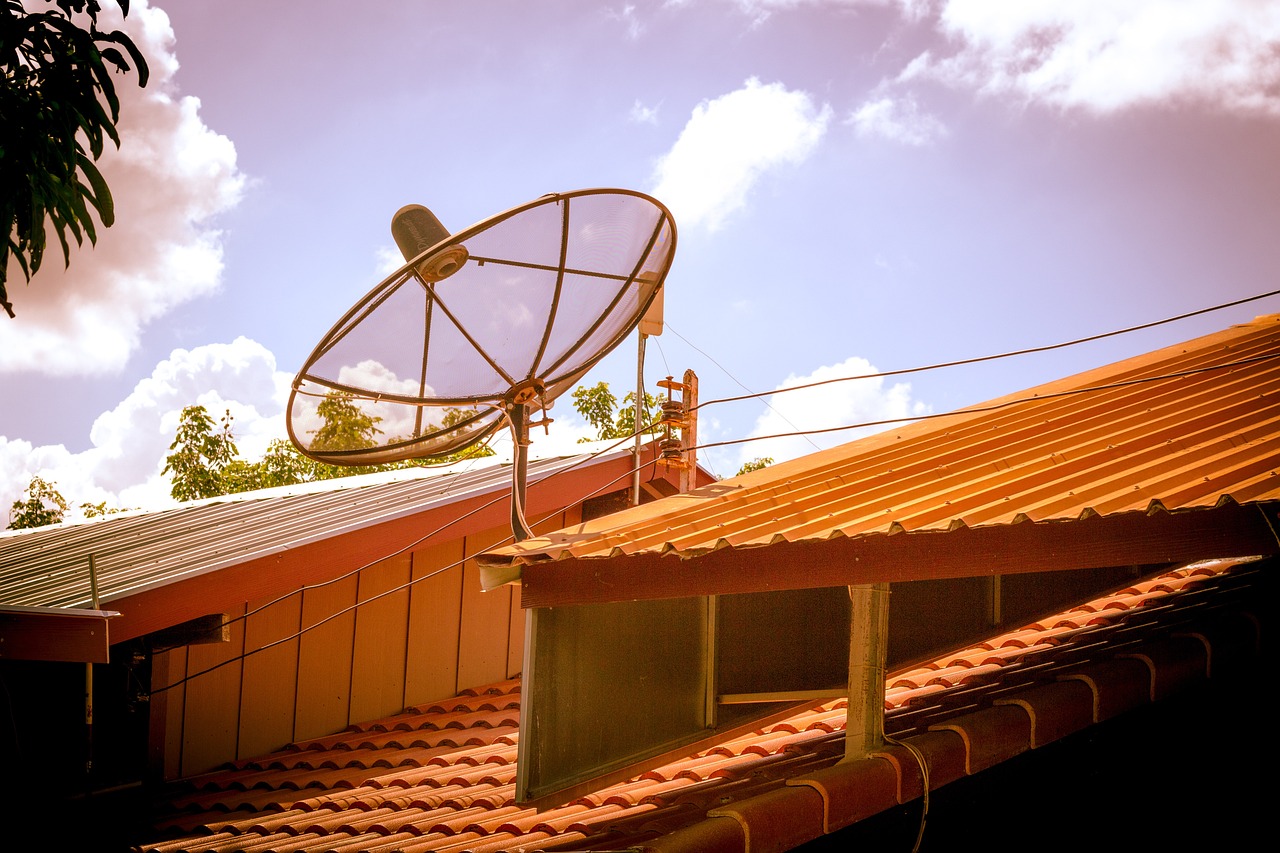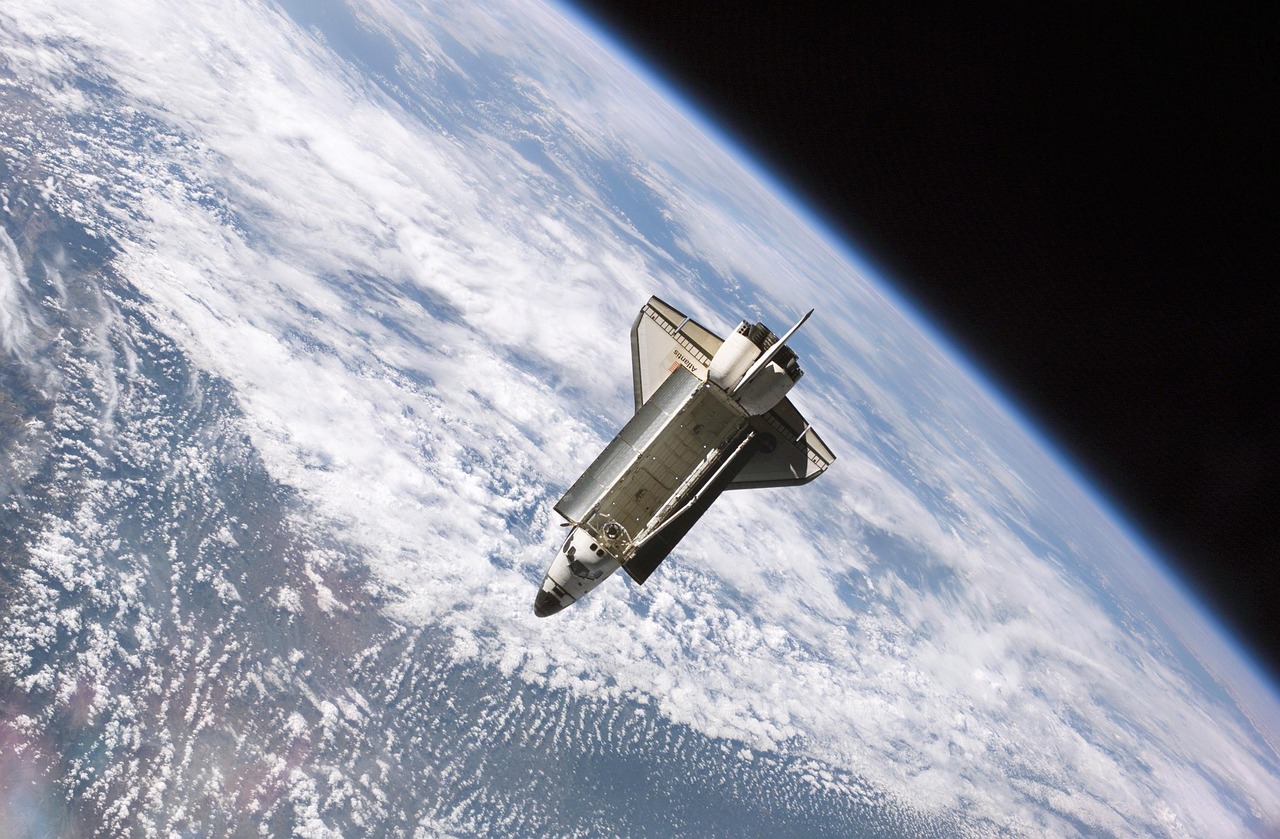The Role of Space in Future Warfare
As we stand on the brink of a new era in military strategy, the importance of space has never been more pronounced. Gone are the days when battles were fought solely on land, sea, or air. Today, space has emerged as a critical battlefield, influencing everything from communication to reconnaissance. With nations racing to establish dominance in this uncharted territory, understanding the role of space in future warfare is essential for grasping the complexities of modern conflict.
In an age where satellites can provide real-time intelligence and missile defense systems rely on space-based technologies, the stakes are incredibly high. Imagine a world where military operations are conducted with the same precision as a video game, where decisions are made in milliseconds based on data collected from orbit. This is not science fiction; it's the reality we are rapidly approaching. The integration of space into military strategies is not just a trend—it's a necessity for national security.
Furthermore, the implications of space warfare extend beyond the battlefield. As countries invest heavily in space technologies, they are also navigating a complex web of international treaties and regulations. The challenge lies in balancing military interests with the need for peaceful exploration and cooperation in space. This intricate dance will shape the future of global security and international relations.
As we delve deeper into this topic, we'll explore the strategic importance of space, the technological advancements that are redefining warfare, and the potential conflicts that may arise as nations vie for control over this new frontier. Prepare to be amazed by the possibilities and the challenges that lie ahead in the cosmos!
- Why is space becoming a critical domain for military operations?
Space provides essential capabilities such as communication, navigation, and surveillance, which are vital for modern warfare. - What role do satellites play in military operations?
Satellites are crucial for real-time intelligence gathering, secure communications, and navigation support during military missions. - How do international treaties affect space warfare?
International treaties, like the Outer Space Treaty, aim to regulate military activities in space and promote peaceful uses of outer space. - What are the risks associated with space debris?
Space debris poses significant threats to operational satellites and can disrupt military operations if not managed properly.

Strategic Importance of Space
In today's world, the cannot be overstated. As nations increasingly rely on advanced technologies for military operations, space has emerged as a crucial battlefield. The ability to communicate, gather intelligence, and navigate effectively from above is transforming how wars are fought. Imagine a chess game where the board is not just on a table but extends into the cosmos—this is the new reality of modern warfare.
Space is not merely a backdrop for military activities; it has become a vital component of national security strategies. Countries are investing heavily in satellite systems that enhance their operational capabilities. These systems allow for real-time data collection, enabling swift decision-making processes. For instance, when a nation can monitor enemy movements from space, it gains a significant advantage, akin to having a bird’s-eye view of the battlefield.
Moreover, the integration of space technologies into military strategies has led to a paradigm shift. Countries that can dominate space will likely dictate the terms of engagement on Earth. This reality raises important questions: What happens when nations compete for control over these high-ground assets? How will international relations evolve as military interests in space intensify?
To illustrate the significance of space in modern warfare, consider the following factors:
- Communication: Military operations depend on secure communication channels, which satellites provide. The loss of these channels can lead to chaos on the ground.
- Surveillance: Satellites are essential for reconnaissance missions, allowing nations to keep tabs on potential threats and respond accordingly.
- Navigation: GPS technology, reliant on satellites, is crucial for guiding troops and equipment accurately.
As nations navigate this new frontier, the implications for global security are profound. The race to develop and deploy advanced space technologies is not just about military might; it is also about ensuring national sovereignty and maintaining a balance of power. The strategic importance of space will continue to grow, shaping military strategies and international relations for years to come.
In summary, the strategic importance of space in military operations is clear. As we move further into the 21st century, the nations that can effectively harness the power of space will hold the keys to future conflicts. Understanding this dynamic is essential for anyone interested in the evolving landscape of global security.
- Why is space important for military operations?
Space provides essential capabilities for communication, surveillance, and navigation, making it a critical domain in modern warfare. - What role do satellites play in military strategy?
Satellites offer real-time intelligence and secure communications, which are vital for effective military operations. - How do international treaties affect space warfare?
International treaties aim to regulate the use of space for military purposes, promoting cooperation and preventing conflict.

Technological Advancements in Space Warfare
The landscape of warfare is evolving at an unprecedented pace, and are at the forefront of this transformation. As nations invest heavily in their military capabilities, the role of space has become more crucial than ever. From sophisticated satellite systems to cutting-edge missile defense technologies, the innovations emerging in this domain are reshaping how conflicts may unfold in the future.
One of the most significant advancements is in satellite technology. Satellites are no longer just tools for communication; they are vital assets for intelligence gathering and operational support. Today's military satellites are equipped with advanced sensors that can capture high-resolution images and collect data in real-time. This capability allows military leaders to assess battlefield conditions and make informed decisions swiftly. The effectiveness of these satellites directly influences the outcomes of military operations, making them indispensable in modern warfare.
Satellites play a pivotal role in military operations, providing crucial services that enhance the effectiveness of ground and air forces. Their impact can be categorized into several key areas:
- Communication: Secure communication satellites ensure that military units can coordinate effectively, even in the most challenging environments. This secure communication is vital for mission success.
- Navigation: GPS satellites facilitate precise navigation for troops and equipment, reducing the risk of getting lost in unfamiliar territories.
- Surveillance: Reconnaissance satellites gather intelligence on enemy positions, movements, and capabilities, allowing for strategic planning.
Moreover, the development of missile defense systems is another area where technology has made remarkable strides. These systems increasingly rely on space-based technologies to detect and intercept potential threats before they reach their targets. The integration of space-based radar and tracking systems enhances the effectiveness of missile defense strategies, creating a multi-layered defense architecture that can respond to various threats.
As we look to the future, the implications of these technological advancements are profound. Nations are not only competing to develop superior military capabilities but are also racing to secure their interests in space. The stakes are high, and the potential for conflict increases as military assets become more reliant on space technologies. The question arises: how will nations navigate these complexities while ensuring global security?
In summary, the advancements in space warfare technologies are transforming the military landscape. As nations continue to innovate and invest in these areas, it is essential to understand the implications of these changes for future conflicts. The interplay between technology and strategy will shape the future of warfare, and staying ahead of the curve is crucial for national security.
- What are the key technologies driving advancements in space warfare?
Key technologies include satellite systems for communication and surveillance, missile defense systems, and advanced sensors for intelligence gathering. - How do satellites impact military operations?
Satellites provide critical services such as secure communication, navigation, and real-time surveillance, which are essential for effective military operations. - What role do missile defense systems play in space warfare?
Missile defense systems utilize space-based technologies to detect and intercept threats, forming a crucial part of a nation's defense strategy. - Why is space considered a critical domain for military operations?
Space is vital for communication, intelligence gathering, and navigation, making it a key factor in modern military strategies and operations.

Satellite Systems and Their Impact
In the realm of modern warfare, satellite systems have emerged as a cornerstone of military strategy, acting as the eyes and ears of armed forces across the globe. Imagine a vast chessboard where every move is calculated not just on the ground, but also from above. Satellites provide essential data that influences tactical decisions and operational success. Their ability to gather real-time intelligence allows military leaders to stay one step ahead of their adversaries, making them indispensable in contemporary conflict scenarios.
The impact of satellite systems extends far beyond mere observation. They facilitate communication between units, ensuring that information flows seamlessly even in the heat of battle. This capability enhances coordination, enabling forces to respond swiftly to changing circumstances on the ground. For instance, during joint operations, communication satellites allow different branches of the military to work in unison, sharing critical updates and strategies instantly. Without these systems, the fog of war would be much thicker, leading to potential miscommunications and operational failures.
Moreover, reconnaissance satellites are vital for gathering intelligence on enemy movements, capabilities, and infrastructure. These satellites capture high-resolution images and data, allowing military analysts to assess threats accurately. The intelligence gathered can be the difference between victory and defeat, as it informs strategic planning and resource allocation. For example, if a country can monitor the deployment of enemy troops or the construction of military installations, it can adapt its strategies accordingly, potentially neutralizing threats before they materialize.
To illustrate the significance of satellite systems, consider the following table that highlights their various roles in military operations:
| Type of Satellite | Primary Function | Impact on Warfare |
|---|---|---|
| Communication Satellites | Secure and reliable communication | Enhances coordination and response times |
| Reconnaissance Satellites | Intelligence gathering | Informs decision-making and strategic planning |
| Navigation Satellites | Positioning and timing | Ensures accurate targeting and troop movement |
As we look to the future, the role of satellite systems in military operations is only set to increase. With advancements in technology, we can expect even more sophisticated satellites capable of performing a wider array of functions. This evolution will likely include enhanced capabilities for electronic warfare, cyber operations, and even autonomous systems that can make decisions in real-time. The integration of artificial intelligence into satellite systems could revolutionize how military operations are conducted, providing an unprecedented level of situational awareness.
However, the reliance on satellite systems also presents vulnerabilities. As nations become more dependent on these technologies, they must also consider the risks associated with potential anti-satellite weapons and cyber threats. The ability to disrupt or destroy a nation’s satellite capabilities could significantly alter the balance of power in a conflict. Therefore, securing these systems against such threats is paramount for maintaining military effectiveness in the coming years.
- What are the main types of military satellites? Military satellites can be categorized into communication, reconnaissance, and navigation satellites, each serving distinct roles in supporting military operations.
- How do satellites enhance military communication? Satellites enable secure and instant communication between military units, which is crucial for coordination during operations.
- What are the risks associated with military satellites? Risks include potential cyberattacks and anti-satellite weapons that could disrupt or destroy satellite capabilities, impacting military effectiveness.
- What advancements are expected in satellite technology? Future advancements may include AI integration, enhanced electronic warfare capabilities, and improved real-time data processing.

Communication Satellites
In the ever-evolving landscape of modern warfare, have emerged as the backbone of military operations. These high-tech marvels orbiting our planet are not just shiny objects in the sky; they are crucial for ensuring that military units can communicate effectively across vast distances. Imagine trying to coordinate a complex military operation without the ability to instantly relay information to your team—chaos would likely ensue! This is where communication satellites come into play, providing a robust network that enhances coordination and response times during critical missions.
One of the most significant advantages of communication satellites is their ability to provide secure and reliable communication. Unlike traditional communication methods, which can be susceptible to interception or disruption, satellite communication systems utilize advanced encryption technologies. This ensures that sensitive information remains confidential, allowing military leaders to strategize without the fear of prying eyes. It’s like sending a secret message in a locked box that only your team has the key to—no one else can access the contents!
Furthermore, communication satellites facilitate real-time data transmission, which is vital for decision-making in fast-paced combat scenarios. For instance, during a military operation, commanders can receive live video feeds from drones or reconnaissance units, allowing them to assess the situation and make informed decisions on the fly. This instantaneous communication can be the difference between success and failure, as it enables forces to adapt quickly to changing circumstances on the ground.
To illustrate the impact of communication satellites in military operations, consider the following key functions they perform:
- Coordination of Forces: Ensures all units are aligned and aware of each other's movements.
- Emergency Communication: Provides a reliable backup in case terrestrial networks fail.
- Data Sharing: Facilitates the exchange of intelligence and operational plans among various branches of the military.
Moreover, the role of communication satellites extends beyond mere operational support. They also play a part in strategic deterrence. By maintaining a robust satellite communication network, nations can project power and demonstrate their military capabilities to potential adversaries. This presence in space acts as a deterrent, as it signals that a nation is prepared to respond swiftly and effectively to any threats. In essence, these satellites not only enhance operational efficiency but also contribute to a nation’s overall security posture.
However, it's important to recognize that with great power comes great responsibility. The reliance on communication satellites also introduces vulnerabilities. As nations become more dependent on these systems, the risk of cyberattacks and jamming increases. Adversaries may seek to disrupt communications by targeting satellites, leading to significant challenges in military operations. Therefore, investing in protective measures and developing countermeasures is crucial for maintaining the integrity of satellite communications.
In conclusion, communication satellites are indispensable assets in modern military strategy. They not only enhance operational capabilities but also play a vital role in ensuring national security. As we look to the future, it’s clear that the significance of these satellites will only continue to grow, shaping the way nations conduct warfare in an increasingly complex and interconnected world.
- What are communication satellites used for in the military?
They are used for secure communication, real-time data transmission, and coordination of military operations. - How do communication satellites enhance military operations?
They provide reliable and instantaneous communication, allowing for quick decision-making and effective coordination among forces. - What are the risks associated with communication satellites?
Risks include potential cyberattacks, jamming, and reliance on technology that can be disrupted.

Reconnaissance Satellites
In the ever-evolving landscape of modern warfare, stand as the vigilant eyes in the sky, providing critical intelligence that shapes military strategies. These sophisticated machines orbiting our planet are not just technological marvels; they are essential assets that enable nations to maintain a competitive edge. Imagine having a bird's-eye view of enemy movements, troop deployments, and infrastructure developments—all in real time. This capability is what makes reconnaissance satellites indispensable in today's military operations.
The effectiveness of reconnaissance satellites lies in their ability to gather and transmit vast amounts of data quickly. Equipped with high-resolution cameras and advanced sensors, these satellites can capture images and collect information across a range of spectrums, including visible light, infrared, and radar. This multi-spectral approach allows military analysts to gain insights that are crucial for informed decision-making. For instance, by analyzing imagery from these satellites, military leaders can identify potential threats, assess the strength of enemy forces, and plan their operations accordingly.
One of the key advantages of reconnaissance satellites is their ability to operate without being detected. Unlike ground-based surveillance systems, which can be vulnerable to countermeasures, satellites can provide a persistent watch over areas of interest. This capability is particularly important in high-stakes situations where timely intelligence can mean the difference between success and failure. Moreover, the data collected can be shared across different branches of the military, enhancing coordination and response times.
However, the reliance on reconnaissance satellites also brings certain challenges. The increasing sophistication of anti-satellite technologies poses a significant threat to these vital assets. Nations are investing in systems designed to disrupt or destroy enemy satellites, raising concerns about the vulnerability of space-based assets. Additionally, the sheer volume of data generated by reconnaissance satellites can overwhelm analysts, making it essential to develop advanced algorithms and artificial intelligence tools to process and interpret this information effectively.
In summary, reconnaissance satellites play a pivotal role in modern military operations. Their ability to provide real-time intelligence and surveillance enables nations to make informed decisions and maintain strategic advantages. As technology continues to advance, the importance of these satellites will only grow, further intertwining the fate of military operations with the vast expanse of space.
Frequently Asked Questions
- What are reconnaissance satellites used for?
Reconnaissance satellites are primarily used for military intelligence gathering, monitoring enemy movements, and assessing potential threats. They provide crucial data that informs strategic military decisions. - How do reconnaissance satellites gather data?
These satellites use advanced sensors and imaging technology to capture high-resolution images and collect data across various spectrums, including visible light and infrared. - What challenges do reconnaissance satellites face?
One of the main challenges is the threat posed by anti-satellite technologies, which can disrupt or destroy these assets. Additionally, the large amount of data generated requires sophisticated analysis tools to interpret effectively.

Missile Defense Systems
In the evolving landscape of modern warfare, have emerged as a cornerstone of national security strategies. These systems are not just about intercepting incoming threats; they represent a complex integration of advanced technologies, strategic planning, and international diplomacy. Imagine a high-stakes game of chess, where every move is calculated, and the consequences of a single misstep can lead to catastrophic results. That’s the reality of missile defense in today’s world.
At the heart of these systems lies a sophisticated network of satellites and ground-based radars that work in tandem to detect, track, and intercept hostile missiles. The reliance on space-based technologies cannot be overstated. For instance, early warning satellites are crucial for detecting missile launches, providing vital seconds that can mean the difference between interception and disaster. These satellites are equipped with infrared sensors that can spot the heat signatures of missile launches, enabling defense systems to respond quickly.
Moreover, missile defense systems can be categorized based on their operational capabilities. Here’s a brief overview:
| Type of Missile Defense System | Primary Function | Key Technologies Used |
|---|---|---|
| Ground-Based Midcourse Defense (GMD) | Intercepts long-range ballistic missiles during their midcourse phase | Ground-based interceptors, radar systems |
| Aegis Ballistic Missile Defense | Designed for naval vessels to intercept short to intermediate-range ballistic missiles | Ship-based radar, Standard Missile-3 (SM-3) |
| Terminal High Altitude Area Defense (THAAD) | Targets missiles in their terminal phase just before impact | Mobile ground systems, advanced radar |
These systems not only enhance a nation’s defensive capabilities but also serve as a deterrent against potential aggressors. The mere presence of a robust missile defense system can alter the strategic calculations of adversaries, prompting them to reconsider their military options. However, this arms race in missile defense is not without its challenges. As technology advances, so too do the capabilities of offensive missile systems, creating a perpetual cycle of escalation.
Furthermore, the integration of artificial intelligence (AI) into missile defense systems is revolutionizing the way threats are assessed and neutralized. AI algorithms can analyze vast amounts of data in real-time, improving the accuracy and speed of decision-making processes. This evolution raises critical questions about the future of warfare: Will we see fully autonomous missile defense systems? How will nations ensure accountability in such scenarios? The implications of these advancements are profound and warrant careful consideration.
In conclusion, missile defense systems represent a dynamic and essential component of modern military strategy. As nations invest heavily in these technologies, the interplay between offense and defense will shape the future of warfare. The stakes are high, and understanding the complexities of missile defense is crucial for navigating the challenges of global security.
- What are missile defense systems? Missile defense systems are military strategies and technologies designed to detect, track, and intercept incoming missiles before they can reach their targets.
- How do missile defense systems work? They utilize a combination of satellites, radars, and interceptor missiles to identify and neutralize threats during various phases of a missile's flight.
- What is the significance of space in missile defense? Space-based technologies provide crucial data for early warning systems, enhancing the effectiveness and speed of missile defense operations.
- Are missile defense systems effective? While they significantly increase a nation's defensive capabilities, their effectiveness can be influenced by the sophistication of offensive missile technologies.

International Space Treaties and Regulations
As humanity ventures further into the cosmos, the need for clear and effective international space treaties and regulations has never been more critical. These agreements are designed to govern the use of outer space, ensuring that it remains a domain for peaceful exploration and utilization rather than a battleground for conflict. The framework established by these treaties aims to promote cooperation among nations while preventing the militarization of space, which could lead to catastrophic consequences.
One of the cornerstone documents in this area is the Outer Space Treaty of 1967. This treaty lays down the fundamental principles for the use of outer space, emphasizing that space should be used for peaceful purposes and that celestial bodies are the province of all mankind. It prohibits the placement of nuclear weapons in orbit and asserts that nations are responsible for their space activities, whether conducted by governmental or non-governmental entities. This treaty is a crucial element in maintaining a semblance of order in the vast and unregulated expanse of space.
However, as nations like the United States, Russia, and China ramp up their military capabilities in space, the original intentions of these treaties are being tested. Recent developments, such as the establishment of military branches dedicated to space operations, indicate a shift towards more aggressive postures. This has led to discussions about the need for new regulations that can address the evolving landscape of space warfare.
In addition to the Outer Space Treaty, several other agreements and resolutions contribute to the regulatory framework governing space activities. For instance:
- The Rescue Agreement (1968): This agreement outlines the responsibility of nations to assist astronauts in distress, regardless of their nationality.
- The Liability Convention (1972): This treaty establishes liability for damage caused by space objects, ensuring that nations are held accountable for their actions in space.
- The Registration Convention (1976): This convention requires countries to register their space objects with the United Nations, increasing transparency in space activities.
Despite these treaties, the rise of private space companies has introduced new challenges. With entities like SpaceX and Blue Origin launching satellites and manned missions, the question arises: how do we regulate non-state actors in space? The existing treaties primarily address nation-states, leaving a significant gap in governance for private enterprises. This gap could lead to a chaotic environment where commercial interests overshadow the principles of peaceful exploration.
Moreover, the issue of space debris has emerged as a pressing concern that complicates the regulatory landscape. As more satellites are launched, the risk of collisions increases, creating debris that poses threats not only to operational satellites but also to the future of space exploration. The international community must come together to develop strategies for debris mitigation and removal to ensure that space remains a viable environment for all.
As we look to the future, it is essential to engage in ongoing dialogue about the implications of space militarization and the need for updated treaties that reflect the current geopolitical climate. The potential for conflict in space is real, and without a robust framework of regulations, we risk turning the final frontier into a theater of war.
- What is the Outer Space Treaty?
The Outer Space Treaty is a foundational agreement that outlines the principles for the exploration and use of outer space, emphasizing peaceful purposes and prohibiting the placement of nuclear weapons in space. - How do space treaties affect military operations?
Space treaties aim to prevent the militarization of space, but as military interests grow, there is a pressing need for updated regulations to address new challenges. - What is space debris and why is it a concern?
Space debris consists of defunct satellites, spent rocket stages, and other fragments that pose collision risks to operational spacecraft, complicating future missions and exploration. - Are private companies regulated in space?
Current treaties primarily address nation-states, leaving a regulatory gap for private companies, which is increasingly becoming a concern as they engage in space activities.

Outer Space Treaty
The , formally known as the Treaty on Principles Governing the Activities of States in the Exploration and Use of Outer Space, including the Moon and Other Celestial Bodies, was signed in 1967 and remains a cornerstone of international space law. This treaty establishes a framework for the responsible exploration and utilization of outer space, emphasizing that space should be used for peaceful purposes. The treaty is a response to the burgeoning interest in space exploration during the Cold War and aims to prevent the militarization of space.
One of the key principles of the Outer Space Treaty is the prohibition of nuclear weapons and other weapons of mass destruction in space. This is crucial for maintaining global security and preventing an arms race beyond our atmosphere. Additionally, the treaty asserts that space is the province of all mankind, promoting the idea that exploration should benefit all nations, not just a select few. This principle is vital in ensuring that space remains a domain for peaceful exploration rather than conflict.
Another significant aspect of the treaty is the requirement that nations are responsible for their activities in space, including those conducted by private entities. This means that countries must ensure that their commercial space ventures comply with international law. The treaty also emphasizes the need for nations to avoid harmful interference with the activities of other states in space, which is essential for maintaining cooperation and reducing tensions.
However, as the landscape of space exploration evolves, questions arise about the treaty's relevance in the face of new technologies and military interests. For instance, the rise of private space companies and advancements in satellite technology have sparked debates about whether the treaty adequately addresses the complexities of modern space activities. Furthermore, the increasing military capabilities of nations in space raise concerns about potential violations of the treaty's principles.
To address these challenges, some experts argue for the need to update or expand the Outer Space Treaty to reflect contemporary realities. This could involve creating more specific regulations regarding military activities in space, the management of space debris, and the rights of private entities. The ongoing discussions about the treaty highlight the delicate balance between security and cooperation in the realm of outer space.
In summary, the Outer Space Treaty serves as a foundational document that shapes the legal framework for space exploration and military activities. Its principles promote peaceful use and international cooperation, but as technological advancements and geopolitical tensions evolve, the treaty's adaptability will be crucial in ensuring that space remains a safe and collaborative environment for all nations.
- What is the Outer Space Treaty? The Outer Space Treaty is an international agreement that governs the exploration and use of outer space, emphasizing peaceful purposes and cooperation among nations.
- When was the Outer Space Treaty signed? The treaty was signed in 1967 and continues to be the foundation of international space law.
- What are the main principles of the Outer Space Treaty? Key principles include the prohibition of weapons of mass destruction in space, the responsibility of nations for their activities, and the promotion of space for the benefit of all mankind.
- Is the Outer Space Treaty still relevant today? While the treaty remains significant, ongoing advancements in technology and military interests in space raise questions about its adequacy in addressing contemporary issues.

Recent Developments in Space Policy
In recent years, the landscape of space policy has undergone significant transformations, reflecting a growing recognition of the strategic importance of outer space for national security. As nations invest heavily in their space capabilities, the policies governing these activities are evolving to address new challenges and opportunities. One of the most notable developments is the increasing militarization of space, as countries like the United States, China, and Russia ramp up their efforts to establish a dominant presence beyond Earth’s atmosphere.
For instance, the United States has established the United States Space Force, a branch of the military dedicated to space operations. This move signifies a shift in how military strategies are being formulated, with space now seen as a critical battlefield. The Space Force's mission includes protecting American interests in space, deterring aggression, and ensuring that the U.S. maintains superiority in this domain. This decision has sparked discussions among international allies and adversaries alike, raising questions about the implications for global security.
Moreover, international collaborations are becoming increasingly essential as nations recognize that space is a shared resource. Agreements such as the Artemis Accords, which aim to promote peaceful exploration and utilization of space resources, highlight the need for cooperative frameworks. These accords encourage responsible behavior in space and outline principles for sustainable exploration, ensuring that space remains a domain for peaceful activities rather than a theater for conflict.
However, with these advancements come challenges. The rise of space debris, a byproduct of increased activity in orbit, poses a significant threat to both military and civilian satellites. As nations launch more satellites, the risk of collisions increases, prompting discussions on the need for stricter regulations and debris mitigation strategies. This is where policy must evolve to address the complexities of ensuring space traffic management and the long-term sustainability of space operations.
In addition to debris management, there is an ongoing debate about the weaponization of space. Many countries are wary of the potential for an arms race in orbit, as nations develop anti-satellite weapons and other technologies designed to disrupt or destroy enemy satellites. This has led to calls for new international treaties aimed at preventing the militarization of space and establishing norms for responsible behavior. The challenge lies in balancing national security interests with the need for international cooperation to prevent conflict.
As we look to the future, it is clear that space policy will continue to evolve in response to technological advancements and geopolitical dynamics. The need for comprehensive frameworks that address both the opportunities and risks associated with space activities is more critical than ever. Policymakers must navigate these complexities to ensure that space remains a domain for peaceful exploration and cooperation, rather than a battleground for conflict.
- What is the significance of the United States Space Force? The Space Force aims to protect American interests in space, deter aggression, and ensure U.S. superiority in space operations.
- What are the Artemis Accords? The Artemis Accords are international agreements that promote peaceful exploration and utilization of space resources while encouraging responsible behavior among nations.
- How does space debris affect military operations? Space debris poses a risk to operational satellites, increasing the likelihood of collisions and disrupting military communications and reconnaissance capabilities.
- What are the concerns regarding the weaponization of space? The potential for an arms race in space raises concerns about global security, prompting calls for new treaties to prevent the militarization of space.

Potential Conflicts in Space
As we venture deeper into the cosmos, the potential for conflicts in space looms larger than ever. With nations rapidly expanding their military capabilities beyond our planet, the stakes are high, and the risks are palpable. Imagine a chess game where the board is not just a flat surface but the vast expanse of space, where every move can have monumental consequences. The race for dominance in this new frontier is not just about technological superiority; it’s about national security, strategic advantage, and the very essence of peace in our time.
One of the most pressing concerns is the growing issue of space debris. This debris, a byproduct of past missions and satellite collisions, poses a significant threat to operational satellites and missions. Just think about it: a tiny piece of debris traveling at high speeds can destroy a satellite, leading to a cascade of failures that could cripple military communications and reconnaissance capabilities. The potential for accidents is high, and the implications could be catastrophic. If a military satellite is taken out by debris, the response could escalate tensions between nations, leading to a conflict that could have been avoided.
Moreover, geopolitical tensions among nations are increasingly spilling into space. Countries are not just competing on Earth; they are vying for influence and control in orbit. For instance, the United States, Russia, and China are all ramping up their space programs, each with military implications. The establishment of military branches dedicated to space operations, such as the U.S. Space Force, signals a serious commitment to maintaining dominance in this domain. This competition can lead to misunderstandings and miscalculations, where a show of force in space might be perceived as an act of aggression, potentially igniting a conflict.
In this context, it's essential to consider the legal landscape governing space activities. While treaties like the Outer Space Treaty aim to promote peaceful uses of outer space, enforcement is challenging. As nations push the boundaries of these regulations, the risk of conflict grows. Countries may interpret their rights to self-defense in space differently, leading to scenarios where one nation’s defensive measures are seen as offensive by another. This ambiguity can create a powder keg situation, where a minor incident could escalate into a full-blown conflict.
To mitigate these risks, international cooperation is crucial. Establishing communication channels and frameworks for conflict resolution can help prevent misunderstandings. Just as nations have engaged in arms control talks on Earth, similar discussions in the realm of space could pave the way for a more stable environment. The cooperation between nations in sharing satellite data, for example, could enhance transparency and trust, reducing the chances of conflicts arising from misinterpretations of actions in space.
In summary, as we look to the stars, we must remain vigilant about the potential conflicts that could arise in this new arena. Understanding the implications of space debris, geopolitical tensions, and the legal frameworks governing space activities is essential for navigating this complex landscape. The future of warfare may very well extend beyond our atmosphere, and it is up to us to ensure that this future is one of cooperation rather than conflict.
- What is space debris and why is it a concern?
Space debris refers to defunct satellites, spent rocket stages, and fragments from collisions or disintegration of spacecraft. It poses a risk to operational satellites and can lead to costly damages and potential conflicts. - How do geopolitical tensions affect space activities?
Geopolitical tensions can lead to increased military presence in space, competition for resources, and the potential for misunderstandings that could escalate into conflicts. - What role do international treaties play in preventing space conflicts?
International treaties, such as the Outer Space Treaty, aim to promote peaceful use of space and set guidelines for military activities. However, enforcement and compliance remain challenging. - How can nations cooperate to prevent conflicts in space?
Establishing communication channels, sharing satellite data, and engaging in dialogue about space activities can enhance transparency and trust among nations, reducing the risk of conflict.

Space Debris and Its Threats
As we propel ourselves deeper into the cosmos, one of the most pressing issues we face is the growing problem of space debris. This term refers to the myriad of defunct satellites, spent rocket stages, and fragments from collisions and explosions that now orbit our planet at high speeds. Imagine a busy highway filled with abandoned cars and debris; that’s a bit like what space has become. The threats posed by this debris are not just theoretical; they are a real and present danger to both operational satellites and the safety of astronauts aboard the International Space Station (ISS).
Space debris travels at speeds exceeding 17,500 miles per hour, making even tiny pieces capable of causing catastrophic damage. In fact, a collision with a 1 cm piece of debris can result in the total loss of a satellite. The implications for military operations are significant. Loss of communication or reconnaissance capabilities can severely hinder a nation's ability to respond to threats or gather intelligence. Therefore, understanding the scale and impact of space debris is crucial for maintaining space security.
According to recent estimates, there are over 34,000 pieces of debris larger than 10 cm, and millions of smaller fragments that pose risks to operational spacecraft. The
| Size of Debris | Estimated Quantity |
|---|---|
| Greater than 10 cm | 34,000+ |
| Between 1 cm and 10 cm | 1 million+ |
| Smaller than 1 cm | Over 100 million |
To mitigate these risks, various international organizations and space agencies are working on debris tracking systems and potential removal technologies. For instance, the European Space Agency (ESA) has initiated the ClearSpace-1 mission, which aims to capture and deorbit a piece of space debris. Such initiatives highlight the urgent need for cooperation among nations to manage and reduce space debris effectively.
Moreover, the potential for conflicts arising from space debris cannot be overlooked. As nations ramp up their military capabilities in space, the risk of accidental collisions increases, which could lead to tensions and even hostilities. The geopolitical landscape is shifting, and space is becoming a new arena for competition. Understanding the threats posed by space debris is not just about protecting satellites; it's about ensuring the safety and security of our future in space.
- What is space debris? Space debris refers to non-functional objects in orbit around Earth, including defunct satellites, spent rocket stages, and fragments from collisions.
- Why is space debris a threat? Space debris poses a threat because it travels at high speeds and can collide with operational satellites, leading to damage or destruction.
- How much space debris is there? There are over 34,000 pieces of debris larger than 10 cm and millions of smaller fragments in orbit around Earth.
- What is being done to mitigate space debris? International organizations and space agencies are developing tracking systems and removal technologies to manage space debris effectively.
- Can space debris lead to conflicts? Yes, the risk of accidental collisions from space debris can escalate tensions among nations as military capabilities in space increase.

Geopolitical Tensions and Space
The realm of space is not just a vast vacuum; it is a strategic battleground where nations are vying for supremacy. As countries expand their military capabilities beyond Earth, the potential for geopolitical tensions escalates. The implications of these tensions are profound, affecting everything from international relations to the security of satellites orbiting our planet. Just like a chess game, every move made in space can have ripple effects on Earth, influencing alliances, rivalries, and even the balance of power.
Countries like the United States, Russia, and China are at the forefront of this new frontier, investing heavily in space technologies and military applications. With the establishment of dedicated space forces, such as the U.S. Space Force, the military dimension of space is becoming increasingly apparent. The competition for resources, strategic positioning, and technological advancement in space is akin to the space race of the 20th century, but with far more at stake.
One of the most pressing concerns in this new era is the potential for conflict in space. As nations develop anti-satellite weapons and other military capabilities, the risk of a space-based confrontation rises. This could lead to catastrophic consequences, not just for the nations involved, but for global communications and navigation systems that rely on satellites. The idea of a "space war" may sound like something out of a science fiction movie, but the reality is that the groundwork for such conflicts is being laid today.
Additionally, the issue of space debris complicates matters further. As more satellites are launched and military operations increase, the risk of collisions in space grows. This debris not only threatens operational satellites but also poses a risk to future missions. The increasing amount of space junk is a clear indicator of how geopolitical tensions can have unintended consequences, leading to a chaotic environment that could spark disputes over responsibility and liability.
To better understand the landscape of these tensions, it is essential to recognize the various players involved and their motivations. The table below outlines some key nations and their space military capabilities:
| Country | Military Space Agency | Key Capabilities |
|---|---|---|
| United States | U.S. Space Force | Satellite communications, missile defense, space surveillance |
| Russia | Russian Aerospace Forces | Anti-satellite weapons, reconnaissance satellites |
| China | PLA Strategic Support Force | Satellite navigation, space-based missile systems |
| India | Indian Space Research Organisation (ISRO) | Satellite launch capabilities, reconnaissance |
As we look to the future, it is clear that the interplay of geopolitical tensions and space will shape the way nations interact. The potential for conflict looms large, but so does the opportunity for collaboration. International treaties and agreements, such as the Outer Space Treaty, aim to promote peaceful uses of space and mitigate the risks of conflict. However, the effectiveness of these frameworks will be tested as nations continue to expand their military presence in this new frontier.
- What are the main concerns regarding space militarization? - The primary concerns include the potential for conflict in space, the risk of space debris, and the implications for global security and communication systems.
- How do international treaties impact space warfare? - Treaties like the Outer Space Treaty aim to prevent conflict and promote peaceful uses of space, but their effectiveness is challenged by the increasing militarization of space.
- Which countries are leading in military space capabilities? - The United States, Russia, and China are currently the leading nations in military space capabilities, with significant investments in technology and infrastructure.
Frequently Asked Questions
- Why is space considered a critical domain for military operations?
Space is essential for modern warfare because it influences communication, surveillance, and navigation. Military operations rely heavily on satellite systems for real-time intelligence and coordination, making it a vital component of national security strategies.
- What role do satellite systems play in military operations?
Satellite systems are crucial for providing real-time intelligence, secure communications, and accurate navigation. Their effectiveness can significantly impact the success of military strategies, allowing forces to make informed decisions based on current data.
- How are technological advancements shaping space warfare?
Rapid advancements in technology are enhancing capabilities in space warfare, including improved satellite systems and missile defense technologies. These innovations are necessary for maintaining a competitive edge and adapting to evolving threats in military conflicts.
- What is the Outer Space Treaty and why is it important?
The Outer Space Treaty is a foundational agreement that establishes principles for space exploration, emphasizing peaceful purposes. Its importance lies in its role in regulating military activities in space and promoting international cooperation to prevent conflicts.
- What are the risks associated with space debris?
Space debris poses significant risks to operational satellites and missions by potentially causing collisions. Understanding and managing this threat is crucial for maintaining the safety and security of space operations, as well as preventing conflicts that could arise from such incidents.
- How do geopolitical tensions affect space operations?
Geopolitical tensions among nations increasingly extend into space, influencing military strategies and international relations. Analyzing these dynamics helps anticipate potential conflicts and fosters discussions on cooperation to ensure stability in the space domain.



















